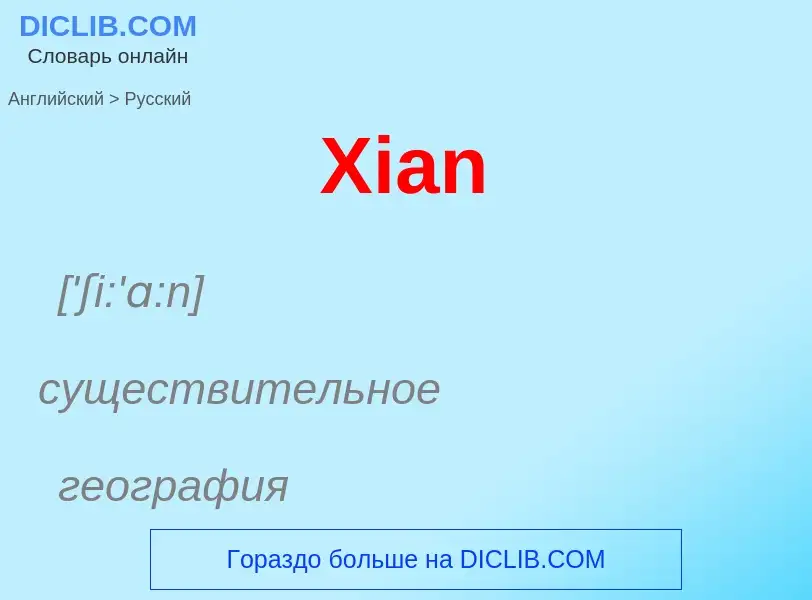ترجمة وتحليل الكلمات عن طريق الذكاء الاصطناعي ChatGPT
في هذه الصفحة يمكنك الحصول على تحليل مفصل لكلمة أو عبارة باستخدام أفضل تقنيات الذكاء الاصطناعي المتوفرة اليوم:
- كيف يتم استخدام الكلمة في اللغة
- تردد الكلمة
- ما إذا كانت الكلمة تستخدم في كثير من الأحيان في اللغة المنطوقة أو المكتوبة
- خيارات الترجمة إلى الروسية أو الإسبانية، على التوالي
- أمثلة على استخدام الكلمة (عدة عبارات مع الترجمة)
- أصل الكلمة
Xian - ترجمة إلى الروسية
['ʃi:'ɑ:n]
существительное
география
г. Сиань
[ʃjʌn]
существительное
Китай
район
округ
[geiz]
общая лексика
гез
гэз
существительное
геология
гэз
опока
تعريف
ويكيبيديا
Xi'an (UK: shee-AN, US: shee-AHN; Chinese: 西安; pinyin: Xī'ān; Chinese: [ɕí.án] (listen)), frequently spelled as Xian and also known by other names, is the capital of Shaanxi Province. A sub-provincial city on the Guanzhong Plain, the city is the third most populous city in Western China, after Chongqing and Chengdu, as well as the most populous city in Northwest China. Its total population was 12,952,907 as of the 2020 census. The total urban population was 9.28 million.
Since the 1980s, as part of the economic growth of inland China especially for the central and northwest regions, Xi'an has re-emerged as a cultural, industrial, political and educational centre of the entire central-northwest region, with many facilities for research and development. Xi'an currently holds sub-provincial status, administering 11 districts and 2 counties. In 2020, Xi'an was ranked as a Beta- (global second tier) city by the Globalization and World Cities Research Network, and, according to the country's own ranking, ranked 17th. Xi'an is also one of the world's top 100 financial centers, according to the Global Financial Centres Index. Xi'an is ranked in the top 30 cities in the world by scientific research output as tracked by the Nature Index, and home to multiple China's prestige universities in Northwest China, including Xi'an Jiaotong University, Northwestern Polytechnical University, Xidian University and Northwest University.
Known as Chang'an in much of its history, Xi'an is one of the Chinese Four Great Ancient Capitals, having held the position under several of the most important dynasties in Chinese history, including Western Zhou, Western Han, Sui, Northern Zhou and Tang. Xi'an is now the second most popular tourist destination in China. The city is the starting point of the Silk Road and home to the Terracotta Army of Emperor Qin Shi Huang, both of which are listed as UNESCO World Heritage sites.

![Meibei Lake, [[Huyi District]], Xi'an Meibei Lake, [[Huyi District]], Xi'an](https://commons.wikimedia.org/wiki/Special:FilePath/Meibei Lake,Huyi District,Xi'an.jpg?width=200)

![A pavilion of the [[City God Temple]] of Xi'an. A pavilion of the [[City God Temple]] of Xi'an.](https://commons.wikimedia.org/wiki/Special:FilePath/The Temple of the Town Deity in Xi'an 18 2013-09.jpg?width=200)
![AMS]], 1955) AMS]], 1955)](https://commons.wikimedia.org/wiki/Special:FilePath/Txu-oclc-10552568-ni49-5.jpg?width=200)





![RGS]], early 20th century) RGS]], early 20th century)](https://commons.wikimedia.org/wiki/Special:FilePath/China West 1906-08 Sven Hedin.jpg?width=200)
![DMA]], 1975) DMA]], 1975)](https://commons.wikimedia.org/wiki/Special:FilePath/Txu-oclc-6654394-ni-45-4th-ed.jpg?width=200)
![DMA]], 1980) DMA]], 1980)](https://commons.wikimedia.org/wiki/Special:FilePath/Operational Navigation Chart G-7, 6th edition.jpg?width=200)
![DMA]], 1990) DMA]], 1990)](https://commons.wikimedia.org/wiki/Special:FilePath/Txu-pclmaps-oclc-22834566 g-7c.jpg?width=200)
